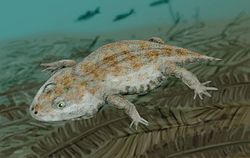Top Qs
Línea de tiempo
Chat
Contexto
Amphibamidae
De Wikipedia, la enciclopedia libre
Remove ads
Amphibamidae es un grupo extinto de temnospóndilos que vivieron desde finales del período Carbonífero hasta comienzos del período Pérmico, en lo que hoy es Europa, Norteamérica y África.
Remove ads
Gerobatrachus es considerado por algunos un taxón hermano de Batrachia, los modernos anfibios.[2]
Presentaban tamaños menores a 40 cm, caracterizándose además por poseer extremidades robustas y proporcionalmente largas, colas cortas, huesos palatales muy reducidos y costillas indeferenciadas y cortas.
Remove ads
Filogenia
Cladograma según Fröbisch y Reisz (2008):[3]
| Amphibamidae |
| ||||||||||||||||||||||||||||||||||||||||||||||||||||||
Referencias
Wikiwand - on
Seamless Wikipedia browsing. On steroids.
Remove ads

